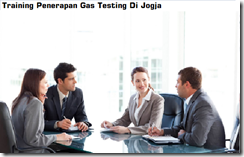
TRAINING AUTHORISED GAS TESTING
DESKRIPSI
Dalam lingkungan industri seperti kilang minyak, pertambangan, dan manufaktur, bahaya gas beracun serta gas mudah terbakar dapat mengancam keselamatan pekerja. Training Authorised Gas Testing atau AGT memberikan pengetahuan dan keterampilan kepada peserta dalam mengidentifikasi, mengukur, serta menilai risiko gas berbahaya menggunakan alat deteksi gas yang sesuai standar. Dengan memahami teknik pengujian gas yang akurat dan prosedur keselamatan yang ketat melalui training pengukuran gas detector, peserta dapat membantu mencegah kecelakaan kerja, meningkatkan kepatuhan terhadap regulasi, serta menciptakan lingkungan kerja yang lebih aman.
Training ini membahas mengenai K3 lingkungan dan tidak tuntas jika dipelajari dalam hitungan jam. Oleh karena itu, diperlukan waktu tersendiri dan bimbingan yang profesional.
MATERI
-
introduction to gas testing
- * Aims
- * Introduction
- * What is gas testing
- * Why is gas testing carried out
- * Case study
- * Who carries out gas testing
- * When is gas testing carried out
- * Terminology
- * Abbreviations
- * summary
-
flammable gases
- * aims
- * the chemistry of fire
- * lower explosive limit
- * upper explosive limit
- * explosive range
- * common gases
- * explosions
- * explosions summary
- * summary
-
toxic gases
- * aims
- * toxic gases & vapours
- * workplace exposure lmit (WEL)
- * toxic gases
- * other toxic gases
- * detecting toxic gases
- * hydrogen sulphide (H2S)
- * characteristics of H2S
- * odour
- * concentration of H2S
- * effects of H2S on equipment
- * asphyxiants
- * long term health impacts
- * personal protective equipment – regulatory requirements
- * selecting PPE – controlling risks from hazardous gases
- * selecting PPE – fitting and ergonomic factors
- * use and maintenance of personal protective equipment
-
properties of gases
- * aims
- * gas clouds movement
- * gas behaviour
- * physical prperties
- * relative density
- * velocity
- * temperature
- * pressure
- * dispersion
- * enclosed areas
- * outdoor areas and open structures
- * summary
-
portable gas detection equipment
- * aims
- * portable and personal gas detectors
- * types of portable and personal gas detectors
- * gas detector principles of operation
- * catalytic detectors – disadvantages
- * gas detectors principles of operation
- * infrared (IR) detectors – principles of operation
- * infrared (IR) detectors – advantages and disadvantages
- * inert atmospheres
- * portable gas detectors – sampling
- * when to use an aspirated detector
- * portable gas detectors – basic checks
- * portable gas detectors – general considerations
- * portable gas detectors – temperature effects
- * limitations of portable gas detectors
- * erratic indications
- * environments that affect readings
- * off-scale readings
- * aspirated detector tubes
- * aspirated detector tubes – operation
- * warning systems
- * flammable gas alarm limits
- * toxic gas alarm limits
- * oxygen gas alarm limits
- * personal gas detectors
- * fixed gas detectors
- * fixed gas detectors – positioning
- * summary
-
gas testing procedures
- * aims
- * process plant
- * hazardous areas
- * zone 0
- * zone 1
- * zone 2
- * gas testing in support of work activities
- * the permit to work system – initial gas tests
- * the permit to work system – repeat gas tests
- * permit to work – continous gas monitoring
- * permit to work – validity of gas tests
- * practical gas testing
- * practical gas testing – evaluation
- * practical gas testing – considerations
- * practical gas testing – air movement
- * practical gas testing – HVAC flow paths
- * practical gas testing – dealing with a suspected leak
- * case study
- * limitations of protective systems
- * summary
SIAPA YANG DAPAT MENGIKUTI TRAINING INI?
- Teknisi Keselamatan dan Kesehatan Kerja (K3)
- Operator di Industri Minyak dan Gas
- Petugas Pemantauan Gas Berbahaya
- Supervisor Area Berisiko Gas
- Inspektur dan Auditor Keselamatan
TRAINER PADA TRAINING INI
Instruktur yang berpengalaman dalam bidang deteksi gas industri akan mengisi pelatihan gas tester.
JADWAL PELATIHAN 2025
- BATCH 1 : 13-14 Januari 2025
- BATCH 2 : 10-11 Februari 2025
- BATCH 3 : 10-11 Maret 2025
- BATCH 4 : 14-15 April 2025
- BATCH 5 : 15-16 Mei 2025
- BATCH 6 : 12-13 Juni 2025
- BATCH 7 : 10-11 Juli 2025
- BATCH 8 : 18-19 Agustus 2025
- BATCH 9 : 17-18 September 2025
- BATCH 10 : 16-17 Oktober 2025
- BATCH 11 : 13-14 November 2025
- BATCH 12 : 15-16 Desember 2025
Calon peserta dapat menyesuaikan jadwal tersebut sesuai dengan kebutuhan
LOKASI
- Yogyakarta, Hotel Dafam Malioboro (6.000.000 IDR / participant)
- Jakarta, Hotel Amaris Tendean (6.500.000 IDR / participant)
- Bandung, Hotel Golden Flower (6.500.000 IDR / participant)
- Bali, Hotel Ibis Kuta (7.500.000 IDR / participant)
- Lombok, Hotel Jayakarta (7.500.000 IDR / participant)
INVESTASI
Investasi pelatihan tersebut menyesuaikan dengan jumlah peserta (on call). *Please feel free to contact us.
Apabila perusahaan membutuhkan paket in house training, anggaran investasi pelatihan dapat menyesuaikan dengan anggaran perusahaan.
BENEFIT
- Module / Handout
- FREE Flashdisk
- FREE Bag or bagpack (Tas Training)
- Training Kit (Dokumentasi photo, Blocknote, ATK, etc)
- 2x Coffee Break & 1 Lunch
- FREE Souvenir Exclusive

